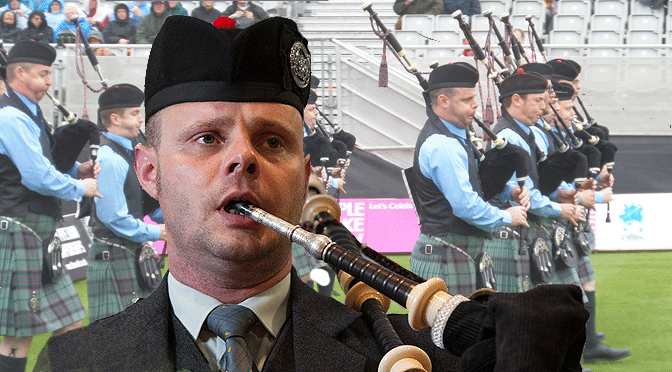Greater Glasgow Police Scotland Pipe Band have held their first band practice with new leading drummer David Henderson at the head of the corps with a ‘very positive’ outcome. The GGPS corps is still largely intact despite the recent upheaval following the departure of long-serving Eric Ward.
Of the nine side drummers that played with the band at the World Pipe Band Championships in August, six have stayed with the police band and one has retired. P/M Iain MacPherson said: ‘Our first practice with David went very well with a very positive response from everyone.’
Former Leading tip Eric Ward has joined the Grade 1 Bleary & District Pipe Band (pictured top) from Northern Ireland. Eric is originally from Banbridge in Northern Ireland. On social media the band say: ‘We look forward to welcoming Leading Drummer Eric Ward to the band. Now we get our heads down for a hard winter’s practice and look forward to the 2017 season.’
 Interesting comments today on the Editor’s review of this summer’s British Pipe Band Championships, in particular the mention of the performance by the Scottish Power band where he wrote: ‘A shaky start where the low Gs and B harmonies clashed throughout the opening tune’.
Interesting comments today on the Editor’s review of this summer’s British Pipe Band Championships, in particular the mention of the performance by the Scottish Power band where he wrote: ‘A shaky start where the low Gs and B harmonies clashed throughout the opening tune’.
This elicited a lengthy and widely read response from P/M Chris Armstrong of Scottish Power (pictured) which justified, in his view, his harmonic approach: ‘‘A shaky start where the low Gs and B harmonies clashed throughout the opening tune.’ That’s interesting from the perspective that the harmonies in the opening tune, a good strong George McIntyre composition which uses the A mixolydian mode, are utilised to compliment this mode which is widely used in Western Music.
‘Basically, this mode is an A major scale with a flattened 7th; i.e. if it was a major key you would have a G sharp but the pipe scale being what it is has a G natural. In order to harmonise correctly in this mode you need the B and low G as the G major/E minor chord are present where you use them. Kilmaho is a fantastic double tonic tune, changing between A and G in every phrase pretty much.’ (Read P/M Armstrong’s full response here.)
Reader Phil Redmond writes: ‘I concur entirely with Editor Robert Wallace …. When playing in the key of A on an instrument designed for the key of D, the G natural is always of concern. Thankfully being the 7th note of the A major scale it is seldom an important part of the melody though at times it does stand out (Blue Bells of Scotland). As far as harmonizing is concerned, the chords that are commonly used in the key of A are the tonic A, C#, E, the sub-dominant D, F#, A, the dominant 7th E, G#, B, D and the relative minor F#, A, C#.
‘Thus, the only time the issue of the G arises is when the applicable chord is the dominant 7th. On such occasions it is better that other than the G is used to accompany the melody.’
 Entries are now closed for the World Solo Drumming being held in Glasgow on October 22 where Inveraray’s Steven McWhirter will be defending his title. Tickets priced £5 for the adult final are available here
Entries are now closed for the World Solo Drumming being held in Glasgow on October 22 where Inveraray’s Steven McWhirter will be defending his title. Tickets priced £5 for the adult final are available here
















Phil, I have to disagree with your rather reductive comment. The G is not a shameful note which we avoid at all cost. You’re correct that it sounds wrong when playing borrowed A major melodies where it would usually be a G#, such as Blue Bells (not a very Gaelic tune and certainly not composed for the pipes!) Maybe we should leave that tune to the brass bands…
However, the tune in question has no C#’s (or C’s) anywhere in it, so it’s clearly not A major. The first class of Western music theory 101 does teach us the I-IV-V chord progression you mention for a major key tune. Kilmaho has a modal minor feel, avoiding the third scale degree. However, since it doesn’t have a i-iv-V underlying chordal progression the term “minor” is just a helpful though misused term borrowed from another musical tradition (much like our distorted use of the Greek church mode monikers).
I disagree with Calum that the tune is in Mixolydian, in which case we would want to see a lot of C# and G, such as Green Hills of Tyrol, Abercairney Highlanders, or Beloved Scotland, and we’d typically find a modal I-VII progression informing the melody. Perhaps, I misunderstood your comment and you were speaking of the key of the pipes and not that specific tune, in which case I’m on your side! The pipes play in a key signature which looks at the quickest glance like D (or B minor) to a Western musician but taking to account the essential drone, we’re in A Mixolydian (Bb+ sounding pitch). Of course that doesn’t mean we can only play A Mix tunes. We often play tunes in D, Phil, though I wouldn’t describe that as the key of the pipes.
All that said, I agree with Charlie Glendinning’s comment on the original article that even well-informed “theory” which takes into account modal scales and progressions falls flat in practice if the effect of the drone isn’t considered (and/or the altered tuning of our chanter intervals to the harmonic series of the drone) and I think this is what Rob Wallace was getting at with his initial comment as well.
Anyway, none of this mumbo jumbo I’ve written makes me play the music any better, so I guess I’d better go practice!
I don’t quite understand why Phil is talking about a key that the tune is not in. It’s A mixolydian, not major, and the V chord of the mixolydian mode is a minor (7th, usually).